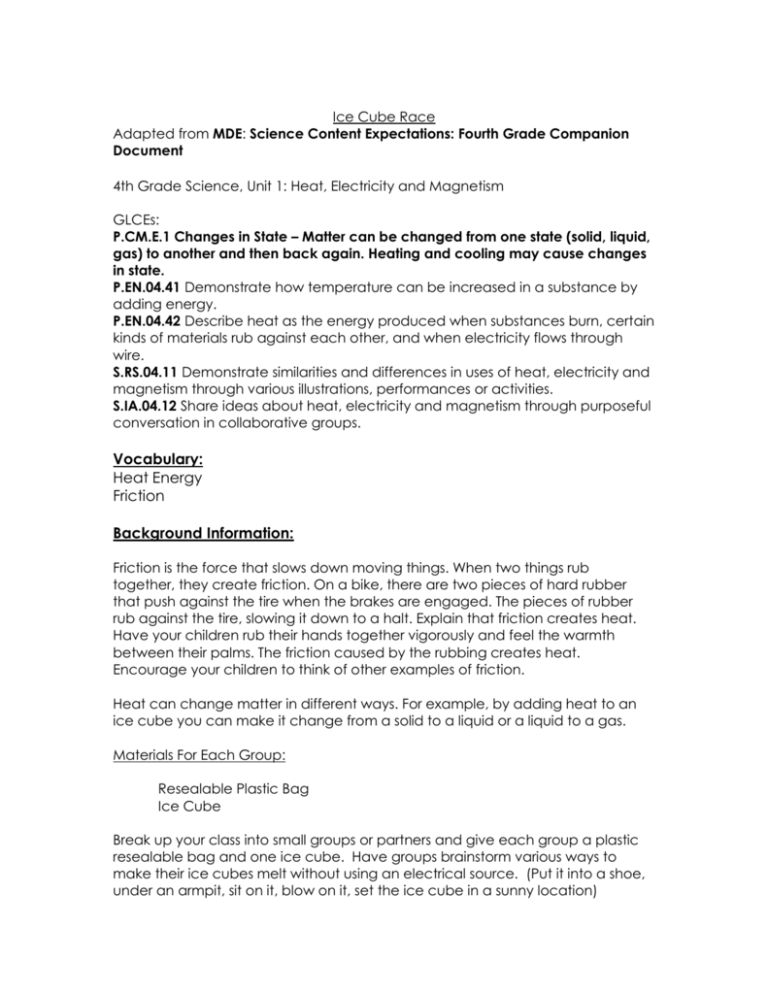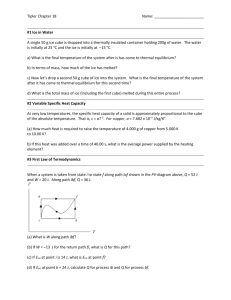File - Science Source
advertisement

Ice Cube Race Adapted from MDE: Science Content Expectations: Fourth Grade Companion Document 4th Grade Science, Unit 1: Heat, Electricity and Magnetism GLCEs: P.CM.E.1 Changes in State – Matter can be changed from one state (solid, liquid, gas) to another and then back again. Heating and cooling may cause changes in state. P.EN.04.41 Demonstrate how temperature can be increased in a substance by adding energy. P.EN.04.42 Describe heat as the energy produced when substances burn, certain kinds of materials rub against each other, and when electricity flows through wire. S.RS.04.11 Demonstrate similarities and differences in uses of heat, electricity and magnetism through various illustrations, performances or activities. S.IA.04.12 Share ideas about heat, electricity and magnetism through purposeful conversation in collaborative groups. Vocabulary: Heat Energy Friction Background Information: Friction is the force that slows down moving things. When two things rub together, they create friction. On a bike, there are two pieces of hard rubber that push against the tire when the brakes are engaged. The pieces of rubber rub against the tire, slowing it down to a halt. Explain that friction creates heat. Have your children rub their hands together vigorously and feel the warmth between their palms. The friction caused by the rubbing creates heat. Encourage your children to think of other examples of friction. Heat can change matter in different ways. For example, by adding heat to an ice cube you can make it change from a solid to a liquid or a liquid to a gas. Materials For Each Group: Resealable Plastic Bag Ice Cube Break up your class into small groups or partners and give each group a plastic resealable bag and one ice cube. Have groups brainstorm various ways to make their ice cubes melt without using an electrical source. (Put it into a shoe, under an armpit, sit on it, blow on it, set the ice cube in a sunny location) Students record the one method they will use to make the ice cube melt and make a prediction about how long it will take. Emphasize that all groups have the same baggie and the same ice cube. The only element that will change is the method used to melt the ice. Each group may choose only one method. Students may use friction to help speed the melting, blow hot air on them, or put the bags in a sunny spot in the classroom. The first group whose ice cubes melts should raise their hands. Discuss the class results. Which method worked the best. Heat, Electricity and Magnetism Name ________________ Ice Cube Race Materials: Resealable Plastic Bag Ice Cube 1. Place an ice cube inside a resealable plastic bag. Your goal is to make the ice cube melt as quickly as possible without using any electrical sources. Brainstorm with your partner about what you could do to make the ice cube melt. List all of the methods that can be tried. ________________________________________________________________________ ________________________________________________________________________ 2. Choose the one method that you will use to make the ice cube melt. Predict how many minutes it will take for your ice cube to melt. ________________________________________________________________________ 3. When your teacher tells you to begin, race to see who can make the ice cube melt the fastest. Record how long it took to melt. ________________________________________________________________________ 4. Discuss the class results. Which method worked the best? Second best? ________________________________________________________________________ 5. Use what you have learned to write a general statement about the most effective way to melt an ice cube. ________________________________________________________________________ ________________________________________________________________________






